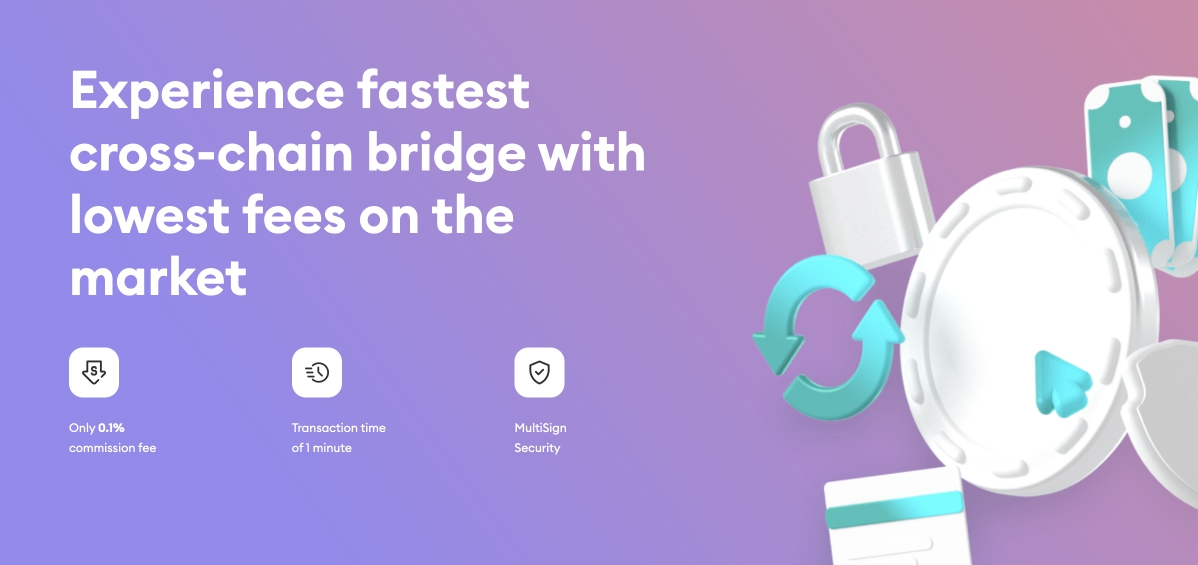Explore the world of crypto bridges. This guide explains different types, how they work, key considerations, and popular options for seamless cross-chain transfers.
How to bridge crypto in 2025?
Bridge is a relatively new term in the cryptocurrency world. Equivalent to the terms crypto bridge and blockchain bridge. It refers to a way of exchanging assets on a decentralized network that does not rely on either CEX (centralized exchange) or DEX (decentralized exchange). Instead, one asset is exchanged for another directly by creating links between blockchains.
The usual way of exchange is to transfer an asset from one's wallet to an exchange, convert it, and then withdraw it back to a wallet on another network. In this case, you have to pay several fees for transactions and withdrawals, as well as lose on the conversion procedure itself. Instead, you should use a crypto bridge, which makes the procedure of exchanging digital assets easier and faster. There are quite a few blockchain bridges, and to choose the best one, you need to know how they are organized and work.
How cryptocurrency exchange by bridge works
From a technical point of view, they are divided into two big groups - Custodial (Trusted) blockchain bridges and Non-Custodial (Trustless) blockchain bridges.
- Custodial blockchain bridges rely on a centralized authority for their work - for example, working under the patronage of a large CEX exchange. A good example of such a bridge would be the Binance Bridge.
- Non-Custodial blockchain bridges take full advantage of decentralization and do not store user funds.
Non-Custodial blockchain bridges work by sharing smart contracts and order routing systems. Unlike Custodial blockchain bridges, they have no withdrawal fees. It is enough to connect to the bridge using a wallet, as it is with connecting to any other DeFi service. You won't need to create an account, go through KYC or otherwise divulge your personal details.
The main disadvantage of Custodial blockchain bridges is having a single point of failure and control over user funds. And for non-custodial blockchain bridges, the main problem is security, as a smart contract can also be hacked. To avoid this danger, you should only use crypto bridges that have passed a security audit and can prove it.
When making an exchange, costs such as bridging fee and transaction fee should be taken into account. The funds that the bridge itself charges for its services are bridging fees. And, transaction fee is the fee for transferring funds between the nodes of the blockchain itself that is being used.
How most cryptocurrency bridges work
Most cryptocurrency bridges work for exchanges between EVM networks. There are also blockchain bridges on areas such as:
- Ethereum-Bitcoin-Ethereum.
- BNB chain-Ethereum-BNB chain.
- Ethereum-Solana-Ethereum.
The popularity of Ethereum bridges is due to the relatively low speed and high fees of this decentralized network. There are not many universal crypto bridges that allow you to work with a large number of decentralized networks at once.
Different blockchains operate on completely different principles, so nothing is actually transferred between different decentralized networks. Instead, equivalent (Wrapped) tokens are created and accounted for between networks using smart contracts:
- A user sends coins on blockchain A to the bridge to receive coins on blockchain B.
- The crypto bridge's smart contract locks his funds on blockchain A and passes the information to blockchain B.
- An amount is generated on blockchain B that is equivalent to the blocked funds on blockchain A.
Also, some bridges rely on a system of pools that hold different cryptocurrencies for exchange - similar to the way a bank exchange office holds currencies from different countries in its coffers.
How Defiway Bridge works
Defiway Bridge refers to Non-Custodial blockchain bridges and does not store user funds. Defiway Bridge's security audit is backed by certificates and you can be fully confident that your transactions are safe. For asset exchange, the critical parameter is bridging fee and transaction fee. Defiway Bridge has the lowest fee among all blockchain bridges, it is 0.1%.
Defiway Bridge is one of the very few crypto bridges that supports Tron network and Base network. The list of supported networks will be expanded over time.
As of today, the following exchange destinations are supported:
- Ethereum - USDT, USDC, WBTC (Wrapped bitcoin).
- BNB chain (BNB) - USDT, USDC, ETH, BTCB (Bitcoin BEP2).
- Polygon (MATIC) - USDT, USDC, WETH (Wrapped Ethereum), BTC.
- Tron (TRX) - USDT, USDC.
- BASE - ETH, USDC.
- Arbitrum One - WBTC, USDC.e, USDT.
- Avalanche C-Chain - WBTC.e, WETH.e, USDC.e, USDT.e.
- Bitcoin - BTC.
- Cronos - WBTC, WETH, USDC, USDT.
- Optimism - WBTC, USDC.e, USDT, USDC.
The use of bridges benefits the entire cryptocurrency industry by connecting previously closed ecosystems on the blockchain. Also, the use of crypto bridges makes blockchain and decentralization technologies more accessible, which stimulates their mass adoption.























